A Little Sea Bathing
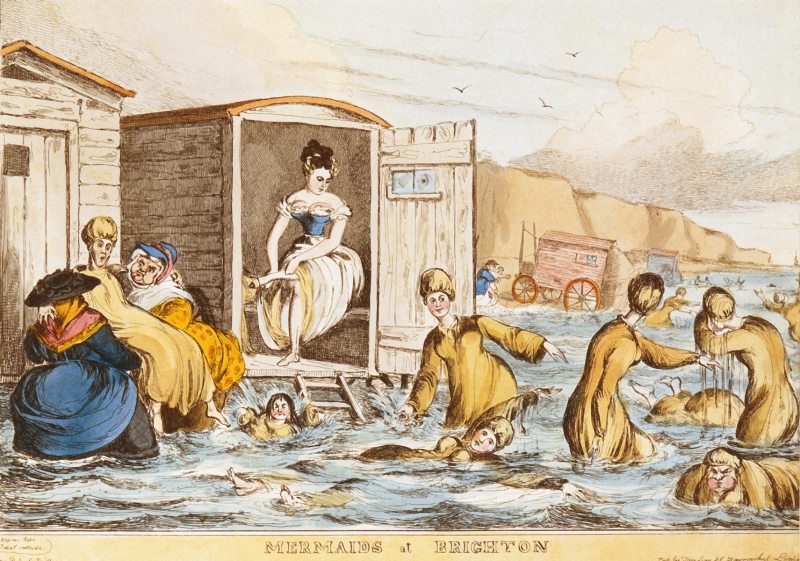
A Little Sea Bathing
With summer drawing to a close, let’s make one last trip to the beach~Regency style
Today, when we imagine a trip to the shore, we think of sun screen, swim suits, picnics, soaking up the sun, and frolicking in the water with our friends and family. In Austen’s day, sea-bathing had an entirely different meaning.
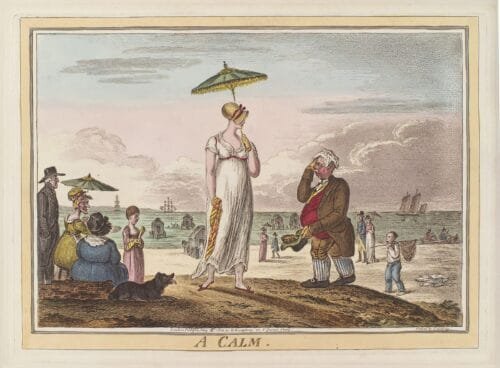
Rather than purely recreational, sea-bathing was recommended by doctors. In 1752, Dr. Richard Russell wrote A Dissertation: Concerning the Use of Sea Water in Diseases of the Glands. He argued that bathing in, and even drinking sea water could cure glandular problems. The notion really took off after the 1780’s when George III chose seaside Weymouth for his recuperation and the Prince of Wales began patronizing the village of Brighton. Doctors recommended immersion in the coldest water possible, so January and February were popular months for sea-bathing. (Personal aside, the ONLY way you could get me in water that cold would be to promise me it would cure something really awful!)
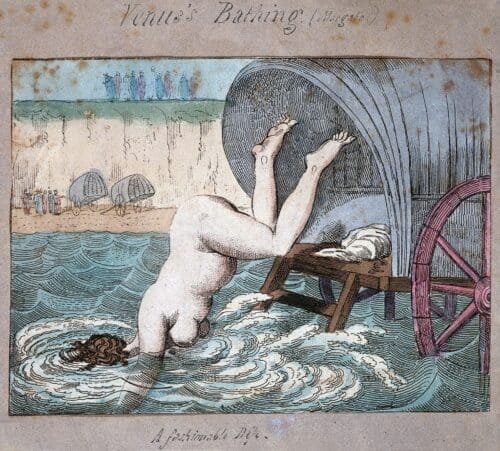
Sea-side towns became popular resorts and communities developed around the tourist economies. Weymouth, Lyme-Regis, Brighton, Margate became some of the most popular destinations.
Since the modern bathing costume had yet to be invented, clever entrepreneurs came up with a solution to keep male and female bathers separated, with their modesty and propriety intact. The first references to this solution, the bathing machine, came in 1721 when Nicholas Blundell wrote of “a conveniency for bathing in the sea.”
He was writing about the bathing machine.
Bathing Machines
Bathing machines were hardly machines in the modern understanding. Essentially small huts on wheels, sea-bathers would climb into the bathing machine where they could change clothes, or disrobe entirely, in private. The machines were then dragged out into the ocean, by horse or occasionally by the paid guides themselves, and bathers could entire into the sea directly from their doors. When finished, the bather would return to the bathing machine to dry off and dress and be returned to the shore. These machines varied in size, some being large enough to hold half a dozen bathers.
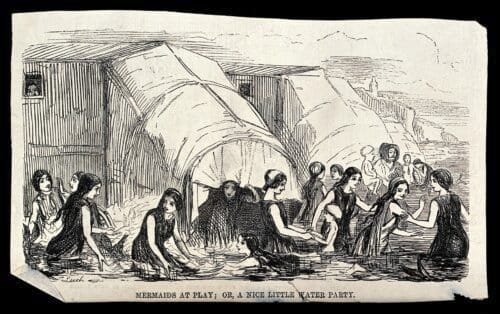
In 1753, Benjamin Beale improved upon the basic design by adding an awning to the doorway that could be extended when the machine was in the water. Thereby bathers would never be exposed in their bathing costumes or bare skin.
Dippers and Bathers
Bathing machines were managed by guides who brought the machines in and out of the water. In some cases they provided flannel bathing gowns for ladies and drawers for men. Bathing costumes were not required by law until the 1860’s.
Buides also assisted bathers in and out of the water. (Remember, most people of the era could not swim.) Since bathing was for health, not recreation, these dippers, for ladies, and bathers, for men, might also vigorously plunge their clients in and out of the (cold) water. (So there was no chickening out of your invigorating sea-bathing.)
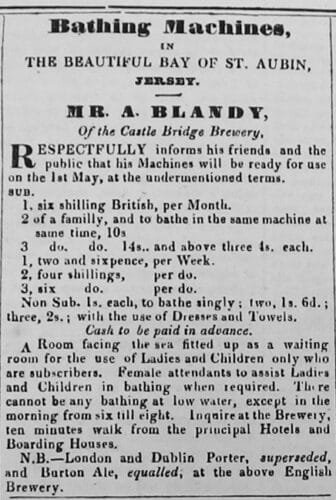
In 1800, it cost approximately 6d to hire a bathing machine and an additional 6d for the guide/dipper/bather. Bathing machines with awnings often cost more. The modern equivalent, when average wages are considered is about £25. So, sea bathing was a luxury affordable by more than just the elite classes.
Bathing machines remained in use until the early 1900’s when the (gender) segregation of beaches ended. After that, bathing machines made a slow transition to become the beach huts that are still commonly seen on English beaches.
I have to be honest, I detest cold water with a passion, so none of this sounds like fun to me. What do you think?
References
https://janeausten.co.uk/blogs/landscape-and-property/seabathing-georgian-style
https://merrynallingham.com/regency-period/sea-bathing-in-the-regency-period/
https://www.regencyhistory.net/2012/08/sea-bathing-in-regency-weymouth.html

In Idaho, when we get a month of 95 degree weather, I’m happy to sit in the kiddie pool with it as cold as it can be. Not having air conditioning may also influence that decision.
I avoid the sun due to the fact that there has been skin cancer in my family. So I don’t so “sea bathing” or even just swimming pools. We used to take the children to the beach regularly when they were small but when they got involved in sports that ended. We were members of a club where they could swim and they all swam on the swim team which took up time after school ended until the end of July. Then school sports practices began.
I learned to swim in the ocean and swimming in pools or ponds or lakes or rivers always seems strange somehow (plus, it’s far more effort to stay afloat!). But I also detest cold water and it takes me forever to get in to the water fully unless it’s very warm. Having some stranger grab me and try to stuff me under the water sounds to me like a recipe for someone getting hurt – and that someone is highly unlikely to be me. Nice ocean water I’ll take – at my own speed, thank you very much.
I can not imagine it would be fun for the dippers trying to wrangle someone in full fear mode. Although that picture does show a couple of hefty ladies doing the dipping. I imagine they could handle someone’s fear of water or the fear of full emersion. I suppose that is why some churches sprinkle rather than use emersion as a form of baptism. LOL! Not being irreligious here… I know some people fear baptism for that reason. They cannot abide being put under water for ANY reason. Thanks for sharing.